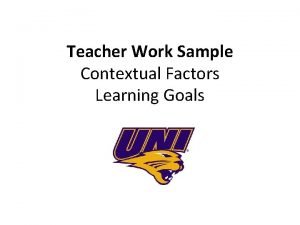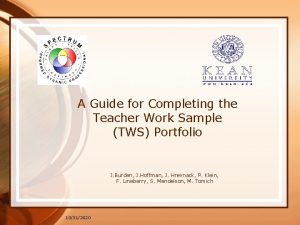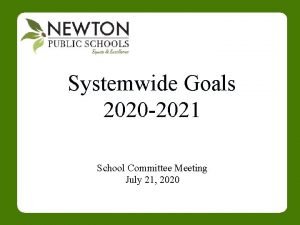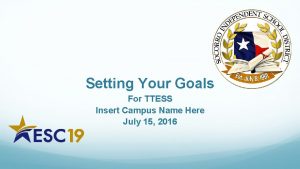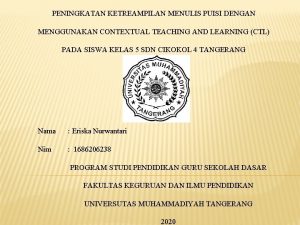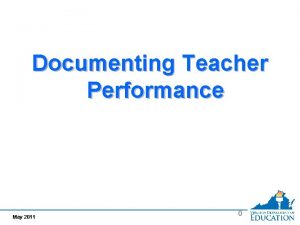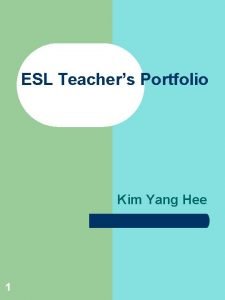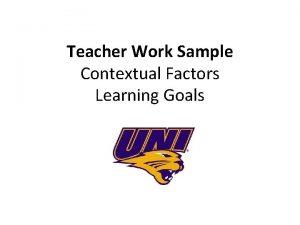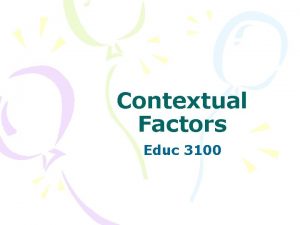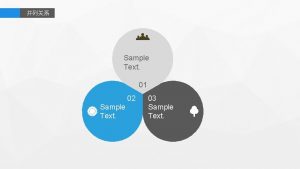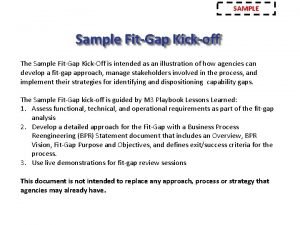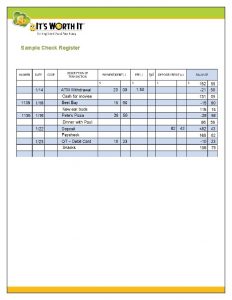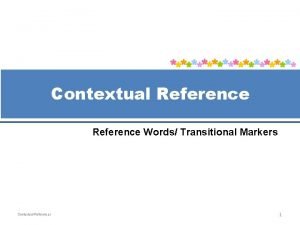Teacher Work Sample Contextual Factors Learning Goals Contextual
















- Slides: 16

Teacher Work Sample Contextual Factors Learning Goals

Contextual Factors • Knowledge of community, district, school, and classroom factors • Knowledge of student characteristics and varied approaches to learning • Knowledge of student’s skills and prior learning (whole group and identified students) • Implications for instructional planning and assessment

Why Contextual factors are Important • The most effective instruction and assessment comes decisions made based on a objective understanding of the community, district, school, whole class characteristics and knowledge of your individual student’s strengths and abilities. • You’ll be asked to reference back to your contextual factors in chapters: Chapter 2, Chapter 3, chapter 4, and chapter 7

Relevance, relevance, RELEVANCE • Description vs identifying relevant characteristics. • Which characteristics are most relevant to you as you plan your instruction and assessment ? • Rely on your professional judgment which characteristics are the most relevant. • Choose three students to focus on: suggested you choose students who provide a variety of differentiation • You may not be ready to pick out your three students at this time.

Devote more space to the contextual factors of students over community, district and classroom • Knowledge of community, district, school and classroom • Knowledge of student characteristics • Knowledge of students’ skills (whole group/and selected students)

Which of these contextual factors would be relevant to your TWS? • The district has a student population of 850 students k 12 • The community is primarily middle to upper-middle class social economic status • The classroom has 24 student desks, white boards on two walls, and reading table near the back. • This is a required class that all students must take before graduation • Of the 22 students in the class, five of the students are identified as English Language learners.

¾ of class is currently reading below grade level • The daily schedule consists of 4 block classes of 90 minutes that alternate between “A” and “B” days. • The technology in the room includes a CD player, an elmo and two computers for student use. • The class consists of 18 students of which 12 are males. • The district recently passed a bond issue for construction of a new middle school.

• What are some of the relevant contextual factors that you’re identifying at your current placement?

Implications You need at least four implications: One from the characteristics of community, school, & classroom; one from class characteristics; one from student skills (group or individual students) “Implication” is a noun: it identifies something suggested or implied by a contextual factor. Share one contextual factor you’ve identified and what’s an implication for your lessons that comes from that contextual factor

Learning Goals • Goals reflect varied levels of learning and are significant and challenging Use a learning theory, such as Blooms’ revised Taxonomy, to indicate the different levels of learning of your goals. You should have 3 to 6 learning goals. Too few and it’s hard to show different levels of learning; too many and your TWS will get too long as you deal with each goal in later chapters.

• Goals are clearly stated at learning outcomes • Focus on specific learning outcomes of the series of lessons you’re teaching. • Don’t include year-long goals • Goals should not be activities

• Goals are appropriate for the development; pre-requisite knowledge, skills, experiences; or other student needs • Done in a narrative manner where you discuss why the goals are appropriate for your group of students; might include scope and sequence or district expectations

• Goals are explicitly aligned with national, state or local standards • It’s best to find the district goals and indicate which district goals are being met with each of your goal. • Show the connection with the Iowa core curriculum • You don’t have to use all three levels of standards to align your goals with

Evaluate each of these learning goals • Students will gain an appreciation for poetry • Students will become better citizens in society • Students will be able to recall the causes of world war one, discuss how world war one contributed to the cause of WW II, and what role each world leader played as the war approached. • Students will understand the rules of basketball

• Students will be able to identify the seven continents with 100% accuracy • Students will write a short story • Students will compare poems by Poe and Dickenson recognizing different literary devices used by each poet. • Student’s watercolor painting will show their use of the dry brush technique.

• Although learning goals that are easy to quantify make the TWS easier; if you have learning goals that have higher levels of learning or involve a performance or creation element; assessing those goals may require a set of criteria for assessment. This will be one of the shorter chapters, but most critical. Your learning goals must align with assessment (chap. 3), instruction (chapter 4), analysis of learning (chap. 6), and references reflection and evaluation (chap. 7)
 Teacher work sample contextual factors
Teacher work sample contextual factors Strategic goals tactical goals operational goals
Strategic goals tactical goals operational goals Strategic goals tactical goals operational goals
Strategic goals tactical goals operational goals Examples of teacher work sample portfolio
Examples of teacher work sample portfolio General goals and specific goals
General goals and specific goals Examples of generic goals and product-specific goals
Examples of generic goals and product-specific goals Cuadro comparativo e-learning b-learning m-learning
Cuadro comparativo e-learning b-learning m-learning Teacher goals for 2020-2021
Teacher goals for 2020-2021 Ttess goal samples
Ttess goal samples Teachers sworn statement of attending school
Teachers sworn statement of attending school Good evening students
Good evening students Adhd treatment goals and objectives for adults
Adhd treatment goals and objectives for adults Selective mutism games
Selective mutism games Contextual teaching and learning
Contextual teaching and learning Self appraisal of a teacher sample
Self appraisal of a teacher sample Star method of interviewing
Star method of interviewing Esl teacher introduction sample
Esl teacher introduction sample
